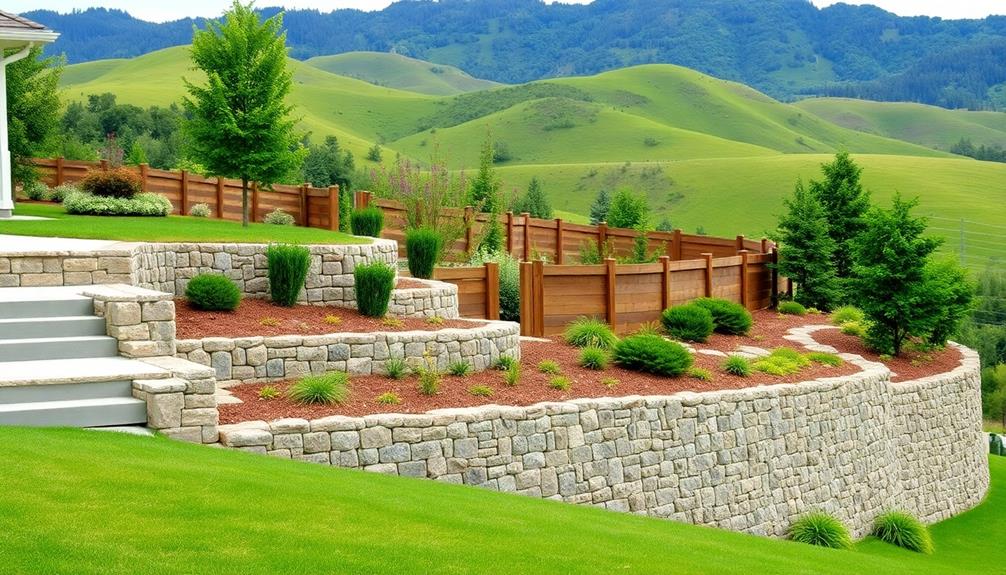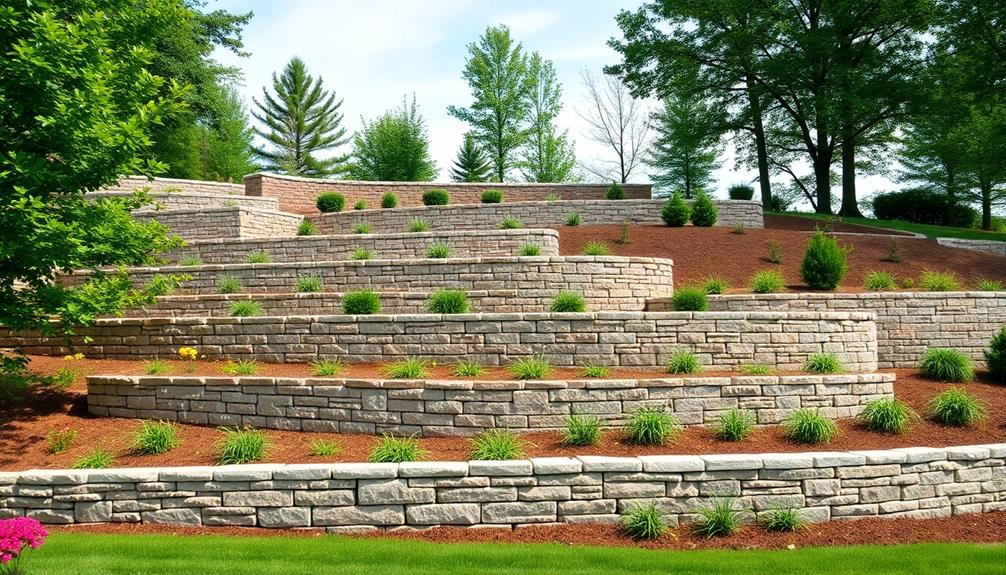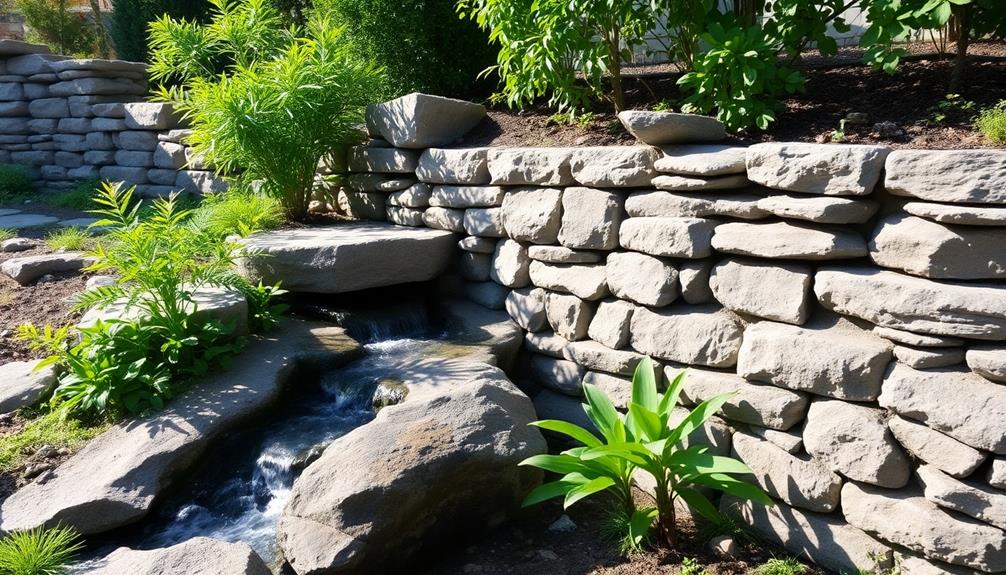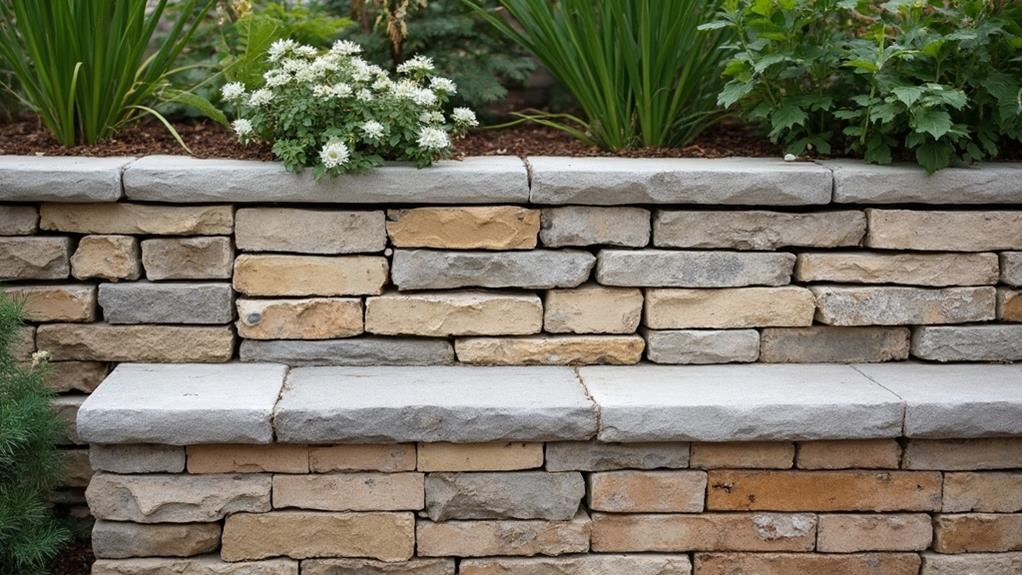Retaining walls are essential in landscape architecture, providing both structural integrity and aesthetic appeal. Common materials for constructing these walls include concrete blocks, renowned for their durability and low maintenance, and natural stone, celebrated for its enduring strength and distinctive visual allure. Treated timber offers a rustic charm, while reinforced concrete delivers unparalleled load-bearing capacity. Other popular choices include gabion baskets, interlocking concrete pavers, and segmental retaining walls, each offering unique installation benefits and style options. Brick and stacked stone provide timeless elegance and robustness, while recycled plastic serves as an eco-friendly alternative. Discovering more insights into these materials reveals their diverse applications.
Table of Contents
ToggleWalls Contractor Highlights
- Concrete blocks offer high load-bearing capacity, weather resistance, and various aesthetic designs.
- Natural stone provides durability, unique appeal, and integrates effortlessly with landscape designs.
- Treated timber is resistant to rot, offers a rustic look, and suits smaller projects.
- Gabion baskets allow natural drainage, easy installation, and adaptability to varying site conditions.
- Recycled plastic is eco-friendly, weather-resistant, and offers sustainable design possibilities.
Types of Retaining Walls

When considering the construction of retaining walls, it is essential to understand the distinct characteristics and applications of various types, such as gravity wall designs, anchored wall techniques, and sheet pile variations.
Gravity wall designs rely on their mass to resist earth pressure and are typically constructed from heavy materials like concrete or stone. At Boulder Walls, materials like limestone, boulders, and granite are frequently used in constructing gravity walls due to their durability and aesthetic appeal.
Anchored walls employ tensioned cables or other supports for additional strength, while sheet pile variations utilize interlocking steel or vinyl sheets driven into the ground to retain lateral earth forces effectively.
Gravity Wall Designs
Gravity wall designs are a fundamental type of retaining wall, characterized by their reliance on sheer mass to resist the lateral pressure of the soil they support. Typically constructed from robust materials such as concrete, stone, or brick, these walls leverage their weight to provide stability without requiring additional reinforcement methods. The effectiveness of gravity walls lies in their simplicity and the intrinsic strength of the materials used, offering both structural support and aesthetic appeal.
The design of gravity walls is elegantly straightforward; their thickness and weight are fine-tuned to counterbalance the pressure exerted by the retained soil. This simplistic approach makes them versatile and adaptable to various environmental conditions and landscaping needs. Aesthetically, the use of natural stone or textured concrete integrates seamlessly into diverse landscapes, providing a sense of harmony and cohesiveness.
Furthermore, the modular nature of some gravity wall materials allows for customization and easy installation, accommodating specific project demands while maintaining structural integrity. This flexibility lends an inclusive aspect to gravity walls, making them a popular choice for both residential and commercial applications. By prioritizing mass and material choice, gravity wall designs guarantee enduring security and aesthetic value.
Anchored Wall Techniques
Anchored wall techniques represent a sophisticated category of retaining wall systems that incorporate additional reinforcements to enhance their stability and load-bearing capacity. These systems often employ tensile elements such as cables or rods that penetrate into the soil or rock behind the wall, anchoring the structure firmly in place. The strategic application of such anchors provides added strength and security, which is indispensable for retaining walls subjected to substantial lateral earth pressures. The integration of mechanical anchors allows these systems to support greater loads than other types of retaining walls of similar dimensions.
Professionals in the field appreciate that the anchored wall technique requires careful design considerations, including precise calculations of anchor distribution, depth, and angle to guarantee optimal performance. This method is particularly useful in scenarios where space constraints preclude the use of wider base structures typically necessary for stability. By employing anchored walls, architects and engineers can achieve the dual goals of maximizing space utility while ensuring robust structural integrity. All stakeholders, from designers to end-users, find value in the increased durability and versatility that anchored wall techniques bring, fostering a sense of belonging to a community committed to excellence in construction practices.
Sheet Pile Variations
Sheet pile walls represent one of the most versatile types of retaining structures commonly utilized in various engineering projects. Distinctly designed for environments requiring efficient space utilization, these walls are manufactured using materials like steel, vinyl, or composite units, providing both durability and adaptability. Their slender profile allows for ease of installation in areas where excavation space is limited, making them ideal for urban development projects and waterfront constructions. Engineers often opt for steel sheet piles due to their high strength-to-weight ratio and capacity to withstand significant bending forces.
In the domain of sheet pile variations, interlocking designs offer increased stability and cohesion under various soil conditions. Innovative engineering advancements have led to the development of corrosion-resistant coatings and synthetic materials, expanding the lifespan of sheet piles. Different profiles, such as U-shaped or Z-shaped configurations, further enhance their structural capacity, allowing for a tailored fit to project specifications. The modularity of sheet pile systems allows for their reuse and recycling, contributing to sustainable construction practices.
Amidst the inherent complexities of retaining wall construction, sheet pile variations embody a harmonious blend of functional design and environmental consideration, fostering a sense of unity and resilience in the built environment.
Benefits

When selecting materials for retaining walls, the benefits to ponder encompass durability and longevity, which guarantee that these structures withstand harsh environmental conditions and maintain their functionality over time.
Boulder retaining walls are an excellent example, as they offer both a powerful statement through their sheer size and a natural allure due to their unique appearance. A comprehensive cost-effectiveness analysis reveals how certain materials offer financial advantages through both initial investment and long-term maintenance savings.
Additionally, options for aesthetic appeal, alongside contemplations for environmental impact, allow for the creation of visually attractive walls that harmonize with their surroundings while minimizing ecological footprints.
Durability and Longevity
One of the most significant advantages of selecting the right retaining wall materials is their durability and longevity. In the domain of landscape design, durability guarantees that the structures not only withstand the forces of nature but also maintain their aesthetic appeal over time.
Materials such as natural stone, concrete blocks, and treated timber are revered for their intrinsic strength, offering a sense of permanence and dependability that speaks to communities prioritizing resilience. Natural stone, for example, has been used for centuries, standing the test of time with its innate resistance to erosion and wear.
Moreover, concrete blocks are engineered to provide substantial load-bearing capacity and weather resistance, making them a popular choice for those seeking long-term stability. Their adaptability to various architectural styles further enhances their appeal.
Treated timber, while not as resistant as stone or concrete, is chosen for its flexibility and the warmth it brings to designs, especially in traditional settings where belonging to historical aesthetics is essential.
Cost-Effectiveness Analysis
Evaluating the cost-effectiveness of retaining wall materials involves analyzing both initial investment and long-term benefits. The foundational choice dictates not only the upfront expenditure but also the lasting impact on maintenance and durability.
Concrete blocks, for example, may have a higher initial cost; however, they are celebrated for their resilience and minimal maintenance needs, making them a wise selection for those seeking value over time. In juxtaposition, timber walls demand lower initial financial outlay, yet often entail frequent maintenance and replacement, which may escalate long-term expenses.
Moreover, it is essential to ponder the environmental costs associated with each material. Recycled or locally sourced materials might offer cost savings and sustainability benefits, appealing to those keen on reducing their carbon footprint.
Offering substantial longevity, natural stone is another cost-effective option; while installation can be labor-intensive, its durability minimizes future upkeep.
Communities benefit from cost-effective solutions by achieving structural integrity that safeguards landscapes and maximizes real estate value. Through careful assessment of both immediate costs and enduring performance, individuals and communities can choose materials that not only meet budget constraints but also forge lasting contributions to their environment, aligning economic with communal well-being.
Aesthetic Appeal Options
Aesthetic appeal in retaining wall materials considerably enhances both the visual landscape and the property's overall value. Choosing materials with visually pleasing qualities transforms the mundane function of a retaining wall into an integral element of your property's design.
Stone, for instance, offers a timeless charm, blending seamlessly with traditional landscapes or modern gardens, providing a textured, varied appearance that mimics natural formations. The earthy tones of stone harmonize with natural surroundings, fostering a sense of belonging to the environment.
Concrete, versatile in its finishes, can mimic the appearance of stone or present a sleek, clean look, which fits well within contemporary settings.
Bricks, with their classic red hue or neutral palettes, offer modular design possibilities that convey warmth and stability, appealing to those seeking an inviting outdoor space. Wood offers a rustic aesthetic, ideal for more informal settings, invoking a sense of organic connection while allowing customization through stains and finishes.
Additionally, the incorporation of plants, creeping vines, or planters into the wall design enhances aesthetic allure, providing texture, color, and ecological unity. By considering aesthetic options, one engages in creating not just a structural necessity but also crafting an inviting, harmonious landscape.
Environmental Impact Considerations
Retaining walls crafted with eco-friendly materials offer notable benefits by minimizing environmental impact while providing essential structural support. Choosing sustainable options, such as reclaimed wood, recycled concrete, or locally sourced stone, reflects a broader commitment to preserving natural resources. These materials not only reduce the carbon footprint associated with long-distance transportation but also encourage the use of resources that would otherwise contribute to waste.
Employing permeable materials, such as porous bricks or green walls, furthers environmental stewardship by improving water management and soil health. These materials facilitate natural water infiltration, reducing runoff and lessening the burden on stormwater systems. Additionally, their integration into landscapes can support local ecosystems, as green walls, in particular, can serve as habitats for various plant and animal species, fostering biodiversity.
From an aesthetic standpoint, environmentally conscious materials often enhance the visual harmony of a space, blending seamlessly with native landscapes. Such integration resonates with a community ethos that prioritizes sustainability and ecological awareness, offering residents not just a structurally sound feature, but a meaningful contribution to the environment. Ultimately, these retaining wall solutions build not only sturdy landforms but also a sense of shared responsibility and environmental integrity within the community.
Porous Rock Enhances Drainage

Porous rock presents significant advantages for retaining wall construction, primarily through its natural drainage benefits that efficiently mitigate water buildup, thereby enhancing the structural integrity of the wall. Its inherent properties contribute to effective erosion control, reducing soil loss and maintaining slope stability, while also offering sustainable construction options that align with environmental conservation efforts.
| Benefits | Characteristics |
|---|---|
| Natural Drainage | Water Permeability |
| Erosion Control | Soil Retention |
| Sustainable Construction | Environmental Friendly |
Natural Drainage Benefits
Utilizing porous rock in the construction of retaining walls offers significant natural drainage benefits, which are indispensable for the longevity and stability of these structures. The intrinsic permeability of porous rocks facilitates the efficient movement of water through the wall, reducing the hydrostatic pressure that can accumulate behind it. This seamless drainage capability is essential in preventing the structural damage that water accumulation can cause, such as shifting, cracking, or even collapse.
In addition to relieving pressure, porous rock materials also contribute to the prevention of waterlogging, which can lead to soil instability and subsequent failure of the retaining wall. By allowing water to pass through rather than accumulate, these materials help maintain the soil structure and integrity around the wall. This intrinsic ability to manage water flow is particularly beneficial in areas prone to heavy rainfall, where effective drainage is imperative.
Moreover, the use of porous rock aligns with sustainable construction practices by minimizing the need for artificial drainage systems. This approach not only enhances the wall's aesthetic by maintaining a more natural look but also reduces the environmental impact associated with non-natural materials. Accordingly, the inclusion of porous rock provides an efficient, eco-friendly solution to drainage challenges in retaining wall construction.
Erosion Control Qualities
Leveraging the inherent permeability of porous rock is crucial for effective erosion control in retaining wall systems. This natural material allows for the passage of water, preventing buildup and guaranteeing proper drainage, consequently mitigating the potential for water-induced structural damage.
The selection of porous rock in retaining wall construction not only facilitates the natural flow of groundwater, reducing hydrostatic pressure, but also integrates seamlessly with the earth's geological processes, promoting stability and minimizing erosion risks.
In communities where environmental harmony is highly valued, the choice of porous rock as a retaining wall material demonstrates a commitment to resilient and adaptive landscaping. Its inclusion in structural design reflects a respect for natural water cycles and the intricate interplay between built and natural environments.
By strategically incorporating porous rock, engineers and landscapers cater to a shared community ethos that prizes sustainability and environmental awareness.
Moreover, using porous rock ensures that retaining walls can withstand diverse weather conditions, providing long-lasting, reliable erosion control. This thoughtful approach engenders shared confidence in the longevity and sustainability of community landscapes, fostering a sense of collective stewardship and pride in maintaining both functional and aesthetically pleasing environments.
Sustainable Construction Options
The benefits of porous rock in retaining wall systems extend beyond erosion control, setting a precedent for sustainable construction practices that prioritize efficient drainage. Porous rocks, such as limestone, sandstone, and certain volcanic rocks, inherently possess a network of tiny interconnected voids, allowing water to pass through freely. This characteristic is not only pivotal in preventing water accumulation behind retaining structures, which can lead to destabilization and costly repairs, but it also promotes effective groundwater recharge.
By facilitating natural water filtration and reducing surface runoff, porous rock contributes to healthier ecosystems and mitigates soil erosion in surrounding environments.
In sustainable construction, using porous rock enhances a project's ecological footprint by aligning with environmental stewardship goals. The option promotes a natural synergy in blending built and natural environments. Additionally, employing locally sourced porous rocks can further reduce transportation energy consumption, supporting the principles of local sustainability.
Community developers and civil engineers, aware of this material's environmental advantages, often advocate for its use, integrating it thoughtfully into infrastructure designs. Consequently, while addressing functional needs, porous rocks in retaining wall systems also emphasize a commitment to preserving environmental integrity and enhancing community resilience against climate change challenges.
Walls Contractor FAQ
What Is the Typical Cost Range for Building a Retaining Wall?
The typical cost range for constructing a retaining wall varies widely, spanning from $40 to $300 per linear foot. Factors such as location, size, design complexity, and material choice substantially/considerably/greatly influence the overall expense, fostering tailored solutions for every community.
How Do I Prevent Water Damage to a Retaining Wall?
To prevent water damage to a retaining wall, guarantee proper drainage by installing weep holes, use a quality waterproofing sealant, and implement a graded backfill to direct water away, fostering structural integrity and long-term community wellness.
What Maintenance Is Needed for a Long-Lasting Retaining Wall?
Regular inspection is essential, identifying signs of erosion, cracking, or bulging. Maintain proper drainage to prevent water accumulation, and promptly repair any structural damage. Ensuring high standards of care fosters a sense of pride and longevity within your community.
Can Plants Be Incorporated Into Retaining Wall Designs?
Incorporating plants into retaining wall designs offers environmental benefits, enhances aesthetic appeal, and fosters community with nature. Selecting suitable species that thrive in your climate and soil conditions guarantees sustainability and complements the structure harmoniously.
What Permits Might Be Required for Constructing a Retaining Wall?
Permits for constructing a retaining wall may include local zoning approvals and engineering assessments to guarantee compliance with safety standards. Collaborating closely with community planning departments fosters a sense of belonging and safeguards adherence to regulations.







